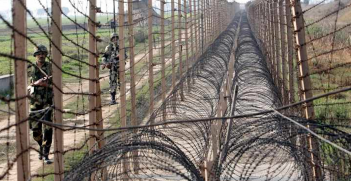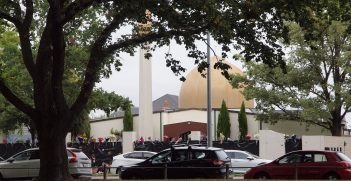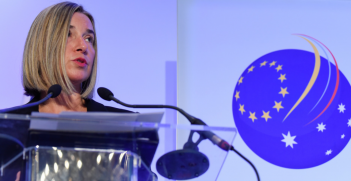Out of the Shadows: Australia’s Intelligence Leaders Speaking Out

The increased public profile of Australia’s intelligence community reflects the nature of contemporary security threats, the need for diverse cooperation and the role of values that distinguish the community from authoritarian intelligence apparatuses.
“Long time listener, first time caller.”
With this clever tweet on 29 October 2018, the Australian Signals Directorate (ASD) launched its new public-facing initiative, ending seven-decades of relative secrecy and closed communication.
That evening, ASD Director-General Mike Burgess followed up with the keynote address to the Australian Strategic Policy Institute’s annual National Security Dinner. Burgess didn’t prevaricate or skirt around the agency’s role “on security grounds.” Instead, he talked expansively on the role of the recently renamed and retasked statutory authority, its history, mission and foreign intelligence collection task, its role in cybersecurity — “both poacher and gamekeeper” — and the challenges of today’s complex threat environment. The traditionally low-profile signals intelligence agency was out of the shadows. And it had a lot to say.
The opening of this window by the ASD chief was just one of a number of high-profile public forays by Australia’s intelligence organisations. In recent years, we’ve seen an increasing array of similar engagements from across the security world.
In 2012 Nick Warner made headlines when he became the first serving director-general of the Australian Secret Intelligence Service (ASIS) to speak publicly about the agency and its work. Warner is now head of the new Office of National Intelligence (ONI) and it’s likely that we’ll hear more from him. Australian Security Intelligence Organisation (ASIO) Director-General Duncan Lewis is no stranger to the public stage. As the official authority on Australia’s security he has, like his predecessors, been the public face of updates on the terrorist and foreign interference threat.
That’s not bad for agencies that, for the most part, were not officially acknowledged as existing until the 1970s. And ASD and ASIS were not subject to legislation and parliamentary scrutiny until 2001.
Australia’s intelligence agencies — ASIO, ASIS, ONI, ASD, the Defence Intelligence Organisation and the Australian Geospatial-Intelligence Organisation — have always been secretive by statute and practice for good reason: to protect capability. Being able to do what they do requires their reach and means to be protected from adversaries, so much of the operations and activities of the intelligence community remain protected from public view. Indeed, in some cases only the agency head and one or two senior officials are publicly named as employees, and it remains a criminal offence to publicly name officers.
So what has been driving these efforts to be more publicly transparent — a somewhat risky move and certainly out of character — by organisations that are considered, as Burgess says, unabashedly meticulous in all they do?
The answer lies both in the complexities of the contemporary threat environment and the more prosaic needs of the modern workplace.
In stepping into the public spotlight, these intelligence leaders are addressing three key issues.
The first is the changing nature of the threat environment. Australia’s intelligence agencies, by and large, had their genesis in military signals and intelligence organisations of the Second World War, evolving later into the state-on-state confrontation of the Cold War. But times have changed. Adversaries are now more varied, as are their targets.
State actors are still at play, and the global tussle between liberal democracies and authoritarian regimes is as active as it was in the height of the Cold War. The increased level of foreign interference led Lewis to brief parliamentarians on the threat and to provide regular and detailed public updates. That led to some extraordinary and unfounded criticism from a former Australian prime minister questioning both the threat and the impartiality of intelligence heads.
Violent non-state actors including terrorists also have a global reach with the potential to cause devastating harm and, as in the Cold War, state actors are using fragile states and insurgencies as proxies or cover for their own activities. The emergence of other non-traditional actors has further muddied the waters. International organised crime has been enabled by developments in global technology. A cyberattack like Wannacry may be ostensibly criminal and technological in nature, but it may also be caused or enabled by disruptive state actors. In this case North Korea was the culprit. And while the immediate impact may be financial, it can also affect essential state infrastructure, while a broader intention may be to undermine trust in government and business institutions.
Together, this means that security and intelligence agencies can’t focus only on traditional threat actors and means, or just on traditional roles and partners. They need to understand cross-over points and engage broadly.
The second driver of the heightened public profile of intelligence agencies is that they can’t deal with the current threats alone, or by sticking to traditional means.
One of the most visible manifestations of agencies seeking new ways of dealing with security has been who they recruit as they diversify their personnel and increase skill sets. ASIO’s official history provides an intriguing insight into recruitment methods of bygone days, which were often limited to a “tap on the shoulder” by an acquaintance, or an approach to some with police or military backgrounds.
Intelligence agencies today advertise openly to attract appropriate candidates and use merit-based recruitment, as befits public sector organisations. A recent ASIS recruitment campaign presented as a test of observation skills was a marketing hit, but also provided valuable PR in highlighting the particular skills of human intelligence practitioners.
The varied and complex threat environment also means there’s a need for agencies to partner broadly.
In counter-terrorism this includes working with affected communities: Duncan Lewis has testified that Australia’s Muslim community has been critical to preventing acts. Terrorist targeting of public places also means enlisted the broader community as security eyes and ears on the ground to report indicators of concern to authorities. While advertising campaigns for the National Security Hotline provide one way to ensure people are aware of how to report what they see or hear, Lewis being interviewed by Fran Kelly on ABC’s AM program on the threat to Australia and how investigations work also carries enormous weight.
The ubiquitous nature of global communications technology, and the cyber threat vector, mean businesses are key partners in protecting Australia from cyberattack. Much of Mike Burgess’s speech focused on links between business and government to secure Australia, and on urging business to be engaged in the common cause of security. The establishment of the Australian Cyber Security Centre aimed to bring business and government agencies closer together: a true partnership operating in the cyber battlefield, not shrouded within an air-gapped security organisation.
These first two issues — the changing threat and the need for diversity within and without — are sensible capability drivers to ensure the ongoing relevance of intelligence agencies to do their jobs.
The third reason for the enhanced voice of intelligence agencies is also laudable but takes place at another level: values. Agencies are squarely focused on what kind of society Australia is and should be. Every time Director-General Lewis and his predecessors appear before inquiries — which has been often in the past decade — or in the media, the focus is on ensuring Australians and our political representatives understand ASIO’s tricky but balanced consideration between intrusion through its considerable investigative powers in the name of security and respecting individual rights and privacy. Burgess echoed this balance of lawful, considered and appropriate means in his 2018 speech, while Warner also stressed the lawful nature of ASIS activities in his landmark 2012 address.
Australia’s intelligence agencies understand their subservience to the rule of law, and to the country’s democratic institutions. The public statements by all leaders highlight not only the lawfulness of agency actions but the oversight and scrutiny of these actions by relevant authorities such as the Inspector-General of Intelligence and Security and the Parliamentary Joint Committee on Intelligence and Security.
This serves two key purposes: first, to demonstrate the alignment of these government agencies with public expectations and to reassure that — despite the clandestine nature of much of their work — they are nonetheless accountable through the democratic system and its balance of powers. Australians need to be reassured their intelligence agencies are acting appropriately, and agencies need to be held to account.
The second is differentiating the role of security and intelligence agencies in liberal democracies from those in authoritarian countries, including the major threat actors today, such as the Chinese and Russian Governments. In the contemporary information warfare environment, these governments seek to portray their intelligence, security and military actions as operating in accordance with international humanitarian law — which they don’t — and incorrectly imply moral equivalence with counterparts in liberal democracies.
Whether in foreign interference, terrorism or transnational organised crime, values are the defining element of today’s threat environment. This is what differentiates Australia and like-minded countries from those state and non-state actors which are the primary sources of insecurity. The extensive use of information operations by hostile actors to undermine democratic institutions requires proactive engagement by all elements of the defence and security apparatus.
Australia’s intelligence leaders have difficult jobs, managing their organisations in a complex, evolving and unrelenting threat environment. But in some ways the public aspect of their roles is the most challenging: and for a liberal democracy in a contested world, probably the most important. That is to ensure a true partnership across community, business and government in dealing with the threat environment, while ensuring that the delicate balance between security and accountability is maintained. An informed, educated and engaged society is a resilient society, and the most powerful defence against hostile threats.
Jacinta Carroll is director of national security at the National Security College of the Australian National University.
This article is published under a Creative Commons Licence and may be republished with attribution.





